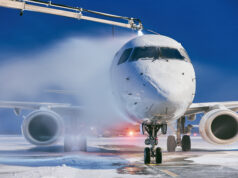“Express 4121, you're the first to go…”

The term pathfinding, as it relates to convective weather and air traffic, is one I have not come across in any FAA literature I have reviewed, but it is a routine practice. ATC uses pathfinding to assess breaks in areas of convection by sending aircraft through these gaps. It’s meant to help the flow of traffic in and out of terminal areas.
You’re number 30 for takeoff.
So, here we are, 30 planes deep in the lineup. The weather has shut down all the departure and arrival fixes. Then miraculously, you get called to the head of the line. Do you know why you’ve been pushed to the front? It’s possibly because you have been chosen to be the pathfinder. To my way of thinking, you should probably know if your aircraft, i.e., you as PIC, have been decreed pathfinder through the muck.
I am aware of no requirement that we be informed when we are elected to make a test -run. I find that to be an issue. I have heard controllers tell the crew they are going to be pathfinders, but what if they don’t tell you? Consider the scenario of unwittingly and unknowingly being anointed pathfinder with no more than a cursory awareness of the current weather picture. This could be quite the recipe for problems ahead!
The main point to remember here is that you’re foraging into new territory. You’re going somewhere in which you will be giving the first PIREP. In this regard, you need to clarify why you’ve moved to the head of the line and if it’s because they have chosen you to be a pathfinder. Once you know you’re in this position, you can strengthen your mental model, with respect to the weather conditions, and compare your assessment to what awaits aloft. Likely, you’ll tighten your belt and sit the flight attendants. Remember, you can also decline.
What goes into the decision to launch a pathfinder?
Simply, I think we should all ask, “Who decides a gap in weather is sufficient to fly through and what are the quantitative measurements for such determination?” ATC professionals, who have a safety mindset are the ones making the decisions. So more importantly, the question becomes, “What are the quantitative measurements and other standards for these determinations?” Are pathfinding aircraft being held to their air carrier’s SOP on thunderstorm avoidance? Is it a ten-mile gap in the weather? Is it a 20-mile gap? If someone in the ATC world is reading this, please chime in. We truly want to know for our own edification.

Your willingness to be a pathfinder comes from your knowledge that:
- As the one chosen, your knowledge of given weather conditions Is sufficient to be taking on this endeavor. This all falls on your responsibilities as the PIC and crew. Regardless of any short comings to this practice, the ball of responsibility rests with you. You need to know all you can about the weather you’re getting into. The better your understanding of the weather, the better the outcome of this endeavor.
- Additionally, and most importantly, it is your prerogative as the PIC/crew to accept or decline this role. You are not obligated. You don’t have to be defensive should you wish to say no. One word should suffice. “Unable.” But, you can’t make that decision if you are unaware that you have been chosen. If you suspect as much, ask. ATC is obligated to give you whatever information you request.
It didn’t go well.
Recently, while sitting in the holding bay, on the frequency, I heard pathfinding being discussed about a particular route. Another aircraft in the holding bay was awaiting word on the route in question. A short few minutes later, ominous words came across the frequency, “It was not successful.” I asked the controller what lack of success meant. It meant excessive deviations. As a result, the route was closed until circumstances changed. It was this exchange between the controller and the pilot that motivated me to ponder the issue and to share it with our reader.
In closing
I bring this matter to light, not a jab at pathfinding, nor as an assertion that this practice is unsafe. My hope is that this article bring awareness, be a catalyst for asking important questions. I invite anyone in the reading audience with insight on the topic to convey it to us, here. If you are aware of how this practice is put into use and by whom, we would like to know more.
I don’t proclaim to be an authority on any given matter, but I hope to raise awareness and increase knowledge of topics that can be useful to us in our common goal of safe and smooth flights. As someone who might be your passenger someday, I am counting on you to take responsibility and know the issues I’ve raised about being a pathfinder. Better information leads to better decisions.



















































